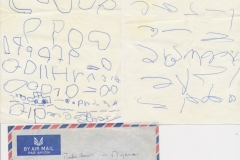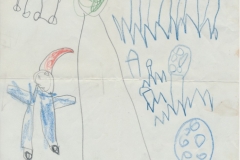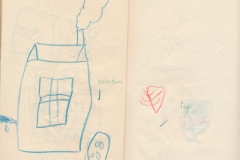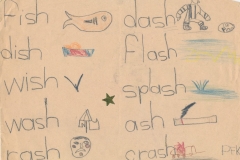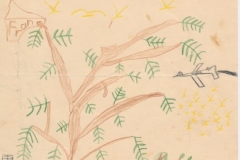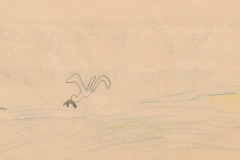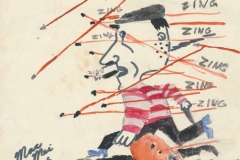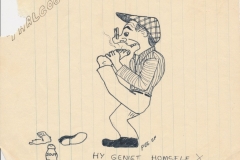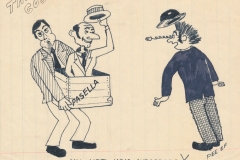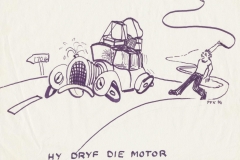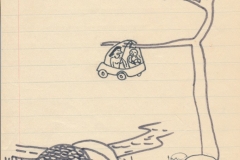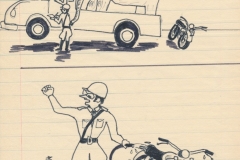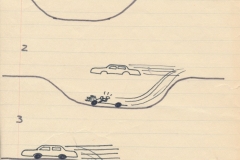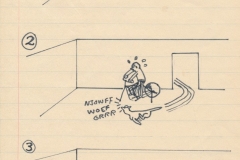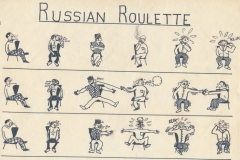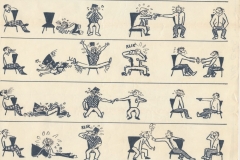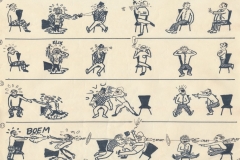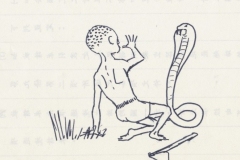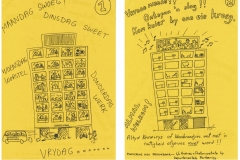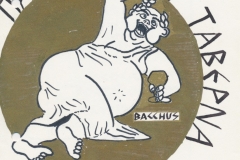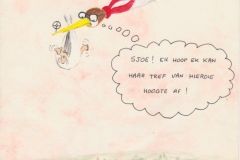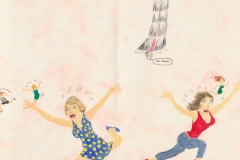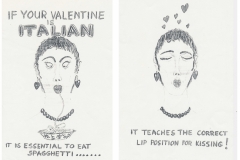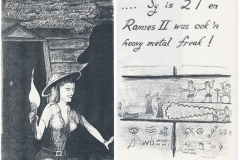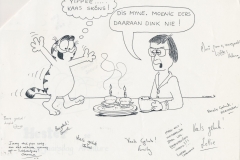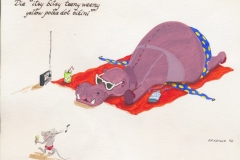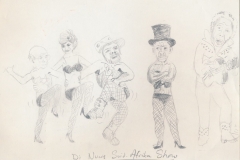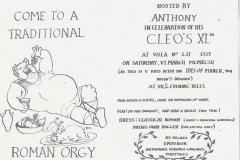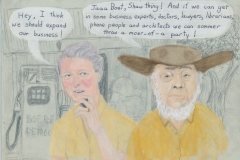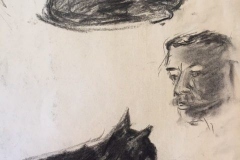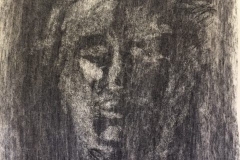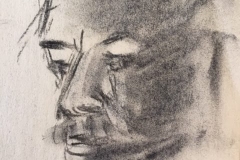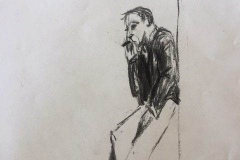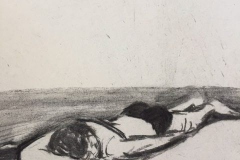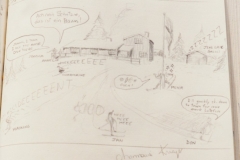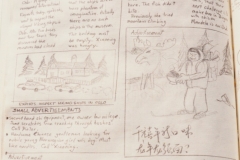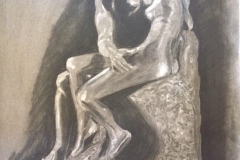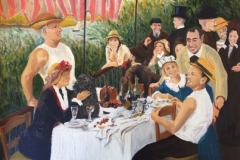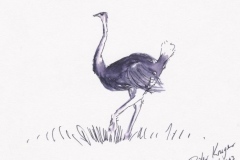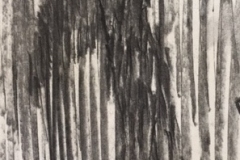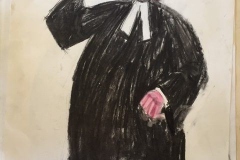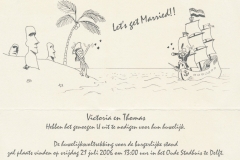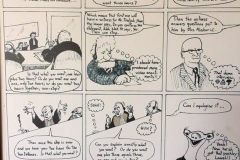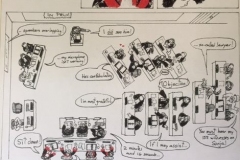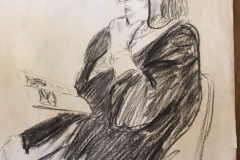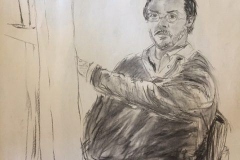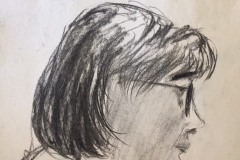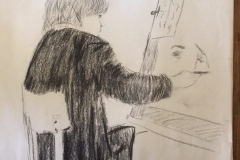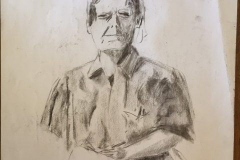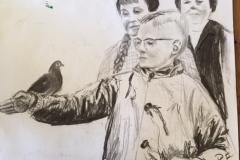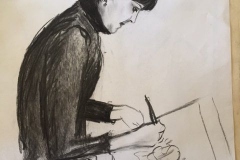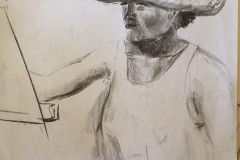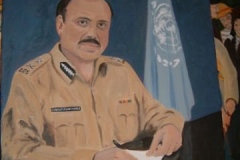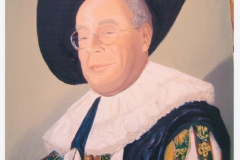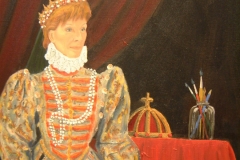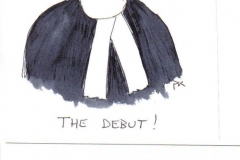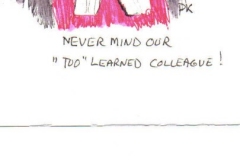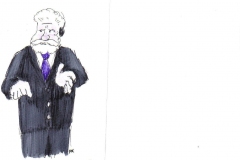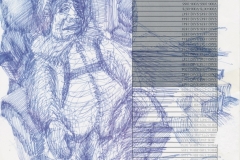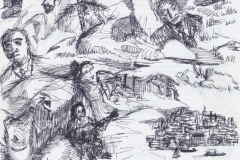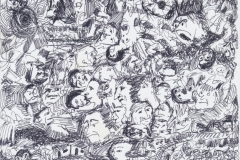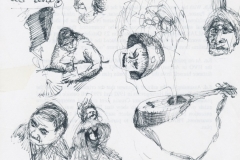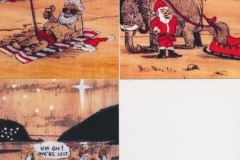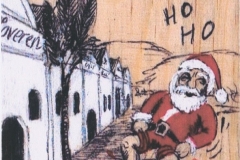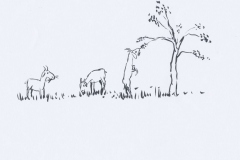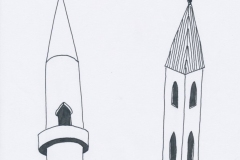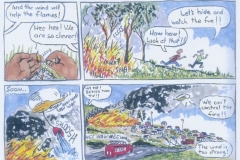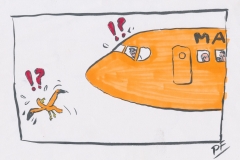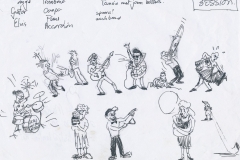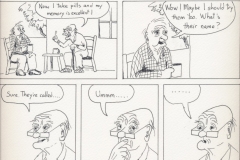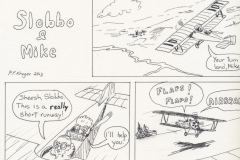How did Igi nor Amos happen? What is the road that eventually led to the birth of our two bumblers?
1960’s
Piet Frans’ surviving artistic archive goes back to 1960. The earliest record of him putting pen to paper is a letter to his grandparents, conveying all the news a four-year old could muster. It even included a picture of a car to assist the interpretation of his message.
Also in 1960 there was a pencil sketch of a boat surrounded by lots of smoke, and an early coloured work of Noddy and Big Ears frolicking in a mushroom field. Noddy was Piet Frans main inspiration at that time.
The beginnings of cartooning interest is possibly visible in a 1961 kindergarden drawing – a red spinning top shows movement lines! In case you wonder about the second picture, the image drawn for “wish” is a chicken’s wish-bone.
The 1962 landscape is endearingly dedicated, on the back, “to Mrs Stapleton for keeps”! It is not known why she gave it back. Some of the images in the other 1962 drawings actually recur more than half a century later in Igi nor Amos cartoons!
The first real cartoon image is the bank robber from May 1965. The inspiration for this image is lost in the mists of time, and we can only wonder whether he got away. And if he did, was there any money left in his bag? The youthful Piet Frans signed his work as “Mac”, the nickname his maternal grandfather addressed him by.
1970’s
In the early 70’s the teenage Piet Frans practised his infant cartooning skills by re-imaging cartoons seen in other magazines. A favoured source was Mad Magazine, especially the little cartoons appearing in the margins. These images were signed as “PEE EF”, which only became Piet Frans many years later. In 1984, at a loss for inspiration, Piet Frans tried to improve on some of these earlier images.
Piet Frans apologises sincerely to all the cartoonists whose work he naively plagiarised in that period.
Another idea copied from Mad Magazine was this dark cartoon from 1974. The original, which is much better than this effort, was by the great Sergio Aragones in a 1963 issue of Mad Magazine.
In 1978 there is a frivolous cartoon playing on the rule that a boxer may not hit an opponent below the belt. This one at least was original, and not stolen from anybody. And then, due to studies, military service and getting married, there was very little artistic activity until around 1986.
1986-1999
This was a productive time for menus, dinner party invitations, personalised cards for various occasions, and various other informal drawing activities. It was during this period that Poppiekreer also advised Piet Frans to abandon his disastrous efforts to create serious art. (A number of pretentious paintings in acrylic and oil are best forgotten.) Her advice was to focus instead on humorous art. If ever there was sound advice, then that was it.
The work from this period, often signed as “PF Kruger” was still developing. Coloured images, for instance the two panels from the “1989 Baby-shower” card and the “1994 Opera Singer”, display a fear of using bold tones and strong shadows.
This period also saw the creation of a children’s book, “The Honesty Trap”, with the text in calligraphy. Being in the wrong format at that time, no publishers were prepared to take it on, and now parts of the theme may be dated. ( The villain, for example, uses a pay-phone in a pre-digital era!)
2000-2011
And then came the new Millenium. Art classes for about three years in the studio of Jean Jones led to a lot of lot of activity. There was art in charcoal, pencil, oil, pen.
Art became an active hobby during this time. Cards for colleagues continued, there were drawings in guest-books. Images 7 and 8 below are from a three page “Hopfesetter Gazette” cartoon making a fun record of an international group of friends’ stay in a cabin in Norway.
The last two images, both farewell gifts to departing colleagues, point towards things to come. The four rows of panels is the same format later used in most of the Igi nor Amos cartoons.
Special efforts also went into developing skills in portraiture, in which Piet Frans had always felt shaky and insecure. Gradually the fear of bolder tones also diminished, although the “Laughing Cavalier” and “Queen Jean” oils could have done with stronger shadows.
The hobby was informally pursued during working hours as well, with extensive doodling during hundreds of meetings. The longer the meeting, the more extensive the doodles. Psychologists would probably have a field day with these.
2012 onwards
After the law, and moving to Knysna, Piet Frans was at last free to pursue cartooning, drawing on a wide range of topics for himself, and others. All the work seen under “Other Projects” on this site comes from this period.
When did Igi nor Amos start?
At last free to create, Piet Frans decided to focus on drawing a cartoon series. He toyed with various themes, and eventually opted for drawing cartoons retelling his favourite funny stories. But the search for the ideal characters to star in these cartoons took some time. The first effort idea was to draw new characters for each page, as in the 2013 “Memory Pills”.
This was abandoned when the image for Amos suddenly just gelled, even though his initial name was “Slobbo”, or “Slobo”.
But the second character remained illusive. “Sid” was tried and rejected. (The name originated with a character from the animated film, Ice Age. I imagined my Sid as speaking with Sid the Sloth’s accent.) Then there was a flirtation with “Mike”, based on a South African boxer/wrestler of the 70’s and 80’s.
Mike did not sit comfortably, and morphed into a black character named Floyd. But it all felt a bit forced and artificial.
And then the ideal name for the series suddenly jumped out from nowhere. “Ignoramus” was the perfect word for naming the two characters- Igi and Amos. And then it would also allow for a standard intro for each cartoon- “Neither Igi nor Amos ever did whatever, but, what if?!”
And with the names decided, and Amos’ image set, Igi emerged. The exact thought processes in creating him are lost. He sort of just happened, and then stuck.
And that is the archaeology of Igi nor Amos, so let that fat lady sing now….

Although neither Igi nor Amos are over yet!
